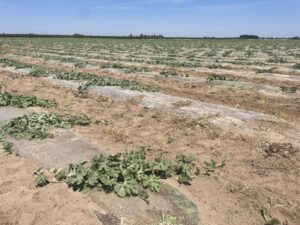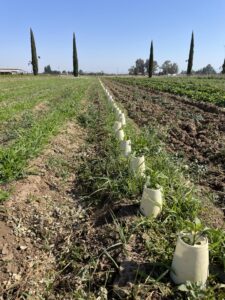Thanks to my University of California Cooperative Extension colleagues, I visited central valley vegetable production last week. Undoubtedly, I learned a lot on this trip. I want to share what I learned with Indiana growers in a few newsletter articles. This short article highlights two things I saw farmers use to extend early-season crop production. In a large watermelon field, I found watermelons are grown on clear plastic (Figure 1). Dr. Zheng Wang, the vegetable crop advisor at the University of California Cooperative Extension, told me that the large-scale watermelon growers use clear plastic for the early crops. The purpose is to warm the soil and get a fast-growing crop. He said the nighttime temperature was in the 50s°F after the crop was planted about a month ago. The watermelons were fast-growing under clear plastic mulch. Occasionally, I saw weeds under the clear plastic. But in general, the crop looks excellent. On a diversified Asian vegetable farm, we saw every pepper plant surrounded by a styrofoam cup (Figure 2). This approach also protected the plants from cool temperatures at the beginning of the season.

Figure 1. Watermelons are on clear plastic mulch.

Figure 2. Pepper plants grow in a foam cup